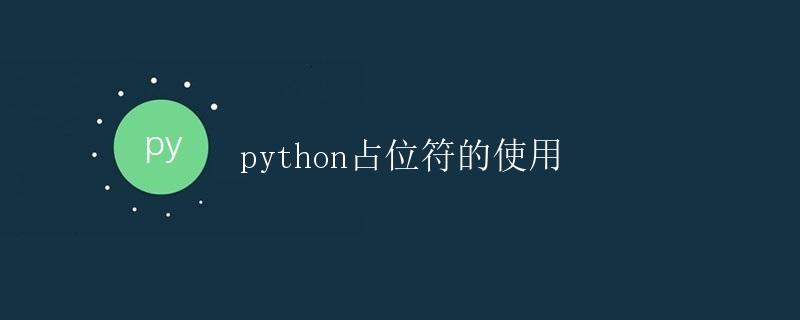python占位符的使用

占位符是在程序中用来表示一个值的符号。在Python中,我们经常使用占位符来格式化输出和字符串拼接。本文将详细介绍Python中常用的占位符及其用法。
%占位符
在Python中,%是最常用的占位符。它可以用来替换字符串中的变量值、格式化输出数字等。下面是%占位符的一些常见用法:
1. 字符串占位符 %s
%s是用于替换字符串的占位符。它可以替换成字符串、整数、浮点数以及其他对象。下面是一个示例:
name = "Alice"
age = 20
print("My name is %s and I'm %d years old." % (name, age))
输出:
My name is Alice and I'm 20 years old.
2. 整数占位符 %d
%d是用于格式化整数的占位符。它可以替换成整数、浮点数等。以下是一个示例:
num1 = 10
num2 = 20
print("The sum of %d and %d is %d." % (num1, num2, num1 + num2))
输出:
The sum of 10 and 20 is 30.
3. 浮点数占位符 %f
%f是用于格式化浮点数的占位符。它可以控制显示的小数位数。以下是一个示例:
pi = 3.14159
print("The value of pi is approximately %.2f." % pi)
输出:
The value of pi is approximately 3.14.
4. 科学计数法占位符 %e
%e是用于格式化浮点数为科学计数法的占位符。以下是一个示例:
num = 1000000
print("The value of %d in scientific notation is %.2e." % (num, num))
输出:
The value of 1000000 in scientific notation is 1.00e+06.
format()方法
除了使用%占位符外,Python还提供了format()方法来格式化字符串。该方法的使用更加灵活,可读性更高。下面是format()方法的一些常见用法:
1. 顺序占位符 {}
{}是用于顺序替换的占位符,默认按照format()中参数的顺序进行替换。以下是一个示例:
name = "Alice"
age = 20
print("My name is {} and I'm {} years old.".format(name, age))
输出:
My name is Alice and I'm 20 years old.
2. 索引占位符 {index}
{index}是用于指定替换位置的占位符,可以按照索引的顺序进行替换。以下是一个示例:
name1 = "Alice"
name2 = "Bob"
print("My name is {1} and his name is {0}.".format(name1, name2))
输出:
My name is Bob and his name is Alice.
3. 关键字占位符 {key}
{key}是用于指定替换位置的占位符,可以根据参数的关键字进行替换。以下是一个示例:
student = {'name': 'Alice', 'age': 20}
print("My name is {name} and I'm {age} years old.".format(**student))
输出:
My name is Alice and I'm 20 years old.
4. 格式化占位符 {key:format}
{key:format}可以用于指定格式化输出的格式。以下是一个示例:
num = 3.14159
print("The value of pi is approximately {:.2f}.".format(num))
输出:
The value of pi is approximately 3.14.
f-strings
在Python 3.6及更高版本中,出现了f-strings(格式化字符串字面量),它提供了一种更简洁的方式来格式化字符串。f-strings以f开头,通过在字符串中使用花括号{}来插入变量。以下是一个示例:
name = "Alice"
age = 20
print(f"My name is {name} and I'm {age} years old.")
输出:
My name is Alice and I'm 20 years old.
f-strings还支持格式化输出和表达式计算。以下是几个示例:
num1 = 10
num2 = 20
print(f"The sum of {num1} and {num2} is {num1 + num2}.")
pi = 3.14159
print(f"The value of pi is approximately {pi:.2f}.")
num = 1000000
print(f"The value of {num} in scientific notation is {num:.2e}.")
输出:
The sum of 10 and 20 is 30.
The value of pi is approximately 3.14.
The value of 1000000 in scientific notation is 1.00e+06.
总结
占位符在Python中是非常实用的工具,它可以帮助我们格式化字符串、控制输出的格式等。本文介绍了%占位符、format()方法和f-strings的用法,并通过示例代码展示了其运行结果。根据实际需求,我们可以选择适合自己的方式来使用占位符。
 极客教程
极客教程